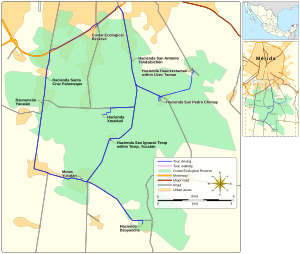Hacienda Xmatkuil facts for kids
Quick facts for kids
Hacienda Xmatkuil
|
|
|---|---|
|
Site of the Yucatán State Fair
|
|

Entrance Hacienda Xmatkuil, Yucatán.
|
|

Cuxtal Ecological Reserve
|
|
| Country | Mexico |
| Mexican States | Yucatán |
| Municipalities | Mérida Municipality |
| Time zone | UTC−6 (CST) |
| • Summer (DST) | UTC−5 (CDT) |
| Postal code |
97316
|
| Area code | 999 |
Hacienda Xmatkuil is a historic place located in the Mérida Municipality in Yucatán, southeastern Mexico. It was once a large farm that became important during the henequen boom in the 1800s. Today, it is part of the Cuxtal Ecological Reserve, which helps protect the area's natural beauty and history.
Since 1974, Hacienda Xmatkuil has been famous for hosting the Yucatán State Fair. Every November, people come from all over to enjoy agricultural shows, fun competitions, and exciting fair rides.
Contents
What's in a Name?
The name Xmatkuil comes from the ancient Mayan language. It means "the place where you pray to God."
Finding Xmatkuil
You can find Hacienda Xmatkuil about 10 kilometers (6 miles) south of Mérida. It's located right on Calle 50, making it easy to visit.
A Look at History
Hacienda Xmatkuil started as a farm. During the henequen boom, it grew a plant called sisal. This plant was used to make strong ropes and other products.
In 1974, the old farm grounds became the home of a big yearly fair. At first, the fair only showed farm animals, machines, and handmade goods. But it quickly grew! Now, it includes restaurants, art contests, sports events, and much more. It's the biggest fair on the Yucatán Peninsula.
The fair happens every year, usually starting on the second weekend of November. It lasts for about three weekends. You can see arts and crafts, animal shows, rodeo events, concerts, and even a fun petting zoo for kids!
On June 28, 1993, the Cuxtal Ecological Reserve was created. This special area helps protect the history of seven large haciendas, their nearby villages, and many ancient Mayan sites. It also protects six cenotes (natural sinkholes with water) and an important water source for Mérida. Hacienda Xmatkuil is one of these protected haciendas.
Inside the Cuxtal Ecological Reserve, you can find these other protected haciendas:
- Hacienda Hunxectamán
- Hacienda San Antonio Tahdzibichén
- Hacienda San Ignacio Tesip
- Hacienda San Nicolás Dzoyaxché (which has a cenote called Dzonot-Ich)
- Hacienda San Pedro Chimay
- Hacienda Santa Cruz Palomeque
- Hacienda Xmatkuil
People of Xmatkuil
Before 1937, many people lived and worked on the henequen farms like Hacienda Xmatkuil. But in 1937, the Mexican government made a big change called the agrarian land reform. This change meant that most of the land was given to groups of farmers called ejidos. The original landowners could only keep a small part of their land.
After this change, fewer people lived directly on the hacienda. The numbers below show how the population of the area around Xmatkuil has changed over time.
According to a count in 2005 by the INEGI, about 357 people lived in the community of Xmatkuil. There were 189 men and 168 women.
| Year | 1900 | 1910 | 1921 | 1930 | 1940 | 1950 | 1960 | 1970 | 1980 | 1990 | 1995 | 2000 | 2005 |
|---|---|---|---|---|---|---|---|---|---|---|---|---|---|
| Population | 125 | ? | 238 | 195 | 156 | 126 | 149 | 400 | 202 | 250 | 258 | 336 | 357 |
Images for kids
See also
 In Spanish: Xmatkuil para niños
In Spanish: Xmatkuil para niños










